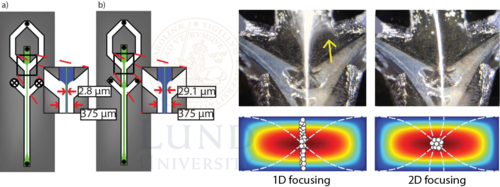Enrichment
Concentrating cells is a frequently performed step in cell biological assays and medical diagnostics. The commonly used centrifuge exhibits limitations when dealing with rare cell events and small sample volumes. A microfluidic chip where particles and cells were acoustically enriched into a smaller volume by removing a larger fluidic fraction through the side outlets while the concentrated sample exited through the central outlet, see left figures below.

Sequential concentration regions and two-dimensional acoustic standing wave focusing of cells and particles were found critical to accomplish concentration factors beyond one hundred times right figures above). Microparticles (5 µm in diameter) used to characterize the system were concentrated up to 194. times with a recovery of 97.1 %. Red blood cells and prostate cancer cells were concentrated 145.0 times and 195.7 times, respectively, with recoveries of 97.2 % and 97.9 %. The data demonstrate that acoustophoresis is an effective technique for continuous flow-based concentration of cells and particles, offering a much needed intermediate step between sorting and detection of rare cell samples in lab-on-a-chip systems.
Jakobsson et al. further developed a concentration device that could reach even higher enrichment factors by using a recirculatory system. By using the same principle as Nordin et al. they achieved >1000-fold enrichment of cells in a label-free manner, at high volumetric throughput (>500 μL/min) and with high recovery (>98.7%) by repeating the enrichment process multiple times.
References
Nordin M and T. Laurell, Two-hundredfold volume concentration of dilute cell and particle suspensions using chip integrated multistage acoustophoresis, Lab Chip, 2012, 12, 4610-4616
Jakobsson O. et al., Thousand-Fold Volumetric Concentration of Live Cells with a Recirculating Acoustofluidic Device, Anal. Chem., 2015, 87, 8497-8502
